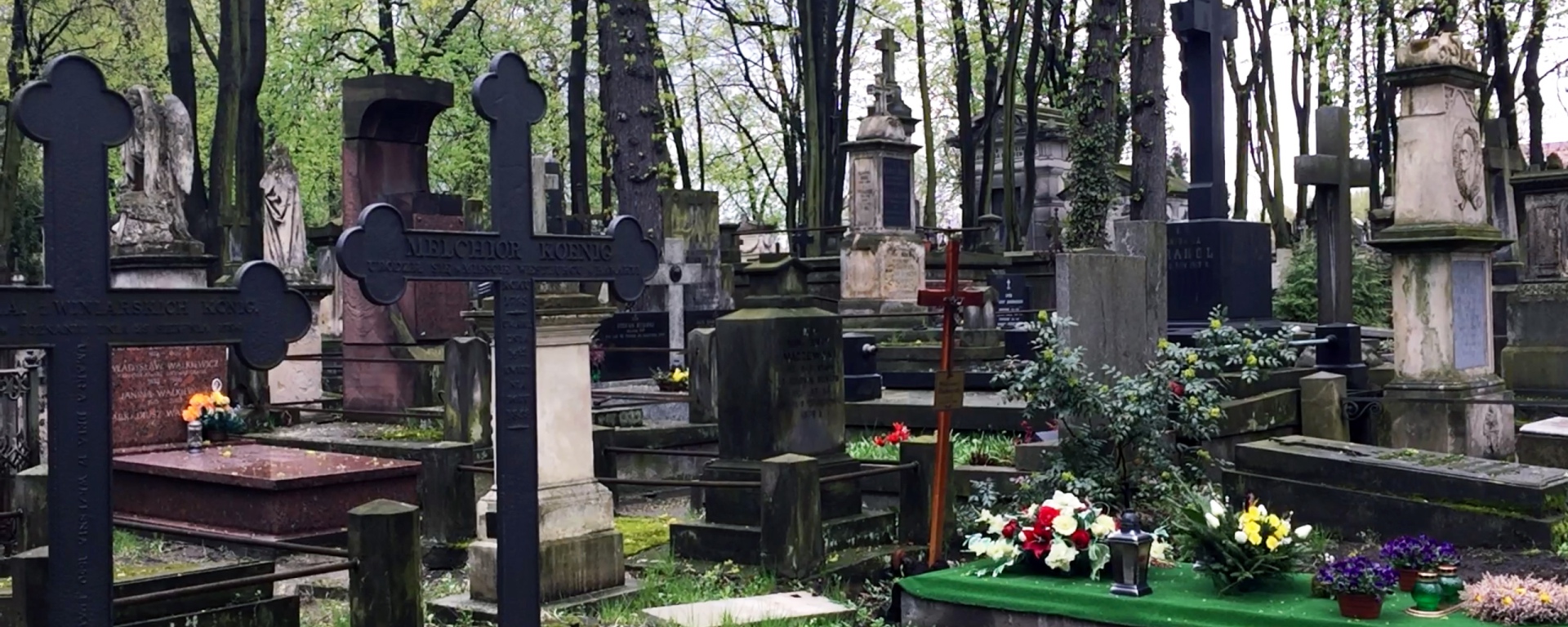This post contains 360° photographs; please give time for them to load, then click and drag each image to rotate. Consider opening them in full-screen mode for the best viewing experience.
At the end of the article, you can view the photographs together with sound recorded on location.
Despite its location in the middle of the city, Powązki Cemetery is eerily quiet, tucked away as it is from the cacophony of cars behind a 3-meter-high brick wall on all sides. Yet, all is not still. There’s a gentle, melodious tweeting of birds and occasional rustle from the arching branches overhead. Within Warsaw’s largest cemetery, one feels as if within a park, contemplating history among the remains of figures who played a role in the capital’s formative moments.
Getting lost inside, the cemetery extends seemingly endlessly, with ornately-carved graves and grandiose family tombs in each direction. Relatives of the deceased regularly visit to clean the graves and leave flowers and candles. The whole of the premises is a national heritage site, cared for by gardeners and the priests working in the adjacent Church of Saint Karol Boromeusz.
Powązki Cemetery has since its inception been the resting place of Poland’s war heroes. Along the southern wall of the catacombs, known as the “Avenue of Notables,” rest soldiers and civilians who fought and died for the country over the past 200 years.
Here we see the grave of Stanisław Batycki. Stanisław was a general in the Polish armed forces, who fought in the Polish-Soviet War of 1920 as well as in World War II. He was captured during a battle in 1939 and killed a year later by the Soviet Army as part of the Katyń Massacre of Polish soldiers. His is but one of many stories immortalized in granite within Powązki’s grounds.
During the occupation of the city, the cemetery was the base of operations for Armia Krajowa, the Polish resistance movement which fought against the Nazis. The Home Army, as they are known in English, hid weapons and met in secret on these grounds. Should they have been captured by either the Nazis or Communists, they could expect torture or a bullet in the head. At that time, not just soldiers, but painters and poets, men and women, some as young as 14, joined the Home Army. Though the cemetery suffered damage during the war, it was completely rebuilt by 1960.
Since opening in 1790, Powązki has expanded over the years to its current size of 43 hectares, now almost as large as the Vatican. It is difficult to pin down the exact number of people buried here, as the cemetery’s record books were destroyed during World War II, but estimates put the figure at over one million people.
Many of the country’s most esteemed writers, poets, artists, thinkers, doctors, bishops, priests, and students have been laid to rest here: the soulful singer Czesław Niemen, the internationally renowned film director Krzysztof Kieślowski, Nobel-prize winning physicist Marie Curie, and the pianist Władysław Szpilman. It’s appropriate that in death, the country’s cultural and artistic leaders remain within these walls. During the years when Warsaw was occupied by the Soviets, Powązki Cemetery was the only place where the Polish language and alphabet were still allowed to be used.
Poland celebrates All Saints’ Day on November 1st. On this day, thousands of visitors come to the cemetery to pay their respects to those buried here. Bouquet-laden graves shimmer with candlelight into the night. Some of the aforementioned heroes and artists may receive dozens of candles on their graves. Yet upon each grave will lay at least one, as visitors ensure that no site remains forgotten.
Powązki’s existence embodies the history and conflict that characterizes the city of Warsaw. From those buried in its tombs we hear a story, one which is constantly updating. Children will one day join their parents in family graves, and birds will continue to serenade fallen heroes. In the meantime, Saint Karol’s Church stands guard like a sentinel until morning mass.
In the video below, you can explore the cemetery while listening to the gentle ambiance of birds and wind playing among the gravestones and trees.
